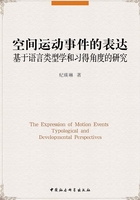
3.1 ENCODING MOTION EVENTS IN ENGLISH
3.1.1 Path satellites and Manner verbs
English is representative of satellite-framed languages and its most important characteristic is that Manner information is typically encoded in verb roots and Path in satellites, to use Talmy's terminology.In this light, the complete expression of a motion event in English involves two grammatical categories and assumes a combinatorial form of Manner verb + Path satellite.The linguistic tools, that is, the satellites encoding Path, mainly consist of verb particles and sometimes prepositions.English has a relatively large set of Path satellites, of which verb particles normally function as free morphemes that can be combined with a wide range of motion verbs.The following table lists some of these Path particles and the specific Path meanings they encode.
Table 3.1 Path particles in English (adapted from Table 1 in Laloi 2007:13)

Apart from verb particles, prepositions, which are normally used in conjunction with nouns in the form of prepositional phrases, are also frequently employed to encode Path of Motion.Prepositions of this type are usually referred to as ‘dynamic prepositions’ (e.g.He ran into the stadium ) and are distinguished from static or locative prepositions (e.g.He is running in the stadium ) Some examples of English dynamic prepositions specifying Path are given below in Table 3.2, below.
Table 3.2 Path prepositions in English(adapted from Table 3 in Laloi 2007: 15)

One notable feature of English Path satellites is that they can be used in accumulation and encode varied aspects of Path information in a motion event, as illustrated in example (13), below:
(13)a.The snake climbed out of the hole from above down the trunk to the ground .
b.She pushed the ball along the pavement across the street into the yard.
Note that in verb-framed languages like French,where Path information is characteristically encoded in a single verb,such accumulation of Path details is simply not possible.However,in Chinese,although Path information is still encoded through the use of verbs rather than particles,the compounding of verbs (e.g.an RVC) and the frequent use of locative prepositional phrases make it possible to express different aspects of Path information in one clause,the source of motion (i.e.cong2 ‘from’), vertical directionality (i.e.shang4 ‘ascend’) and the deixis of motion (i.e.lai 2 ‘come’).Example (14), below, illustrates the expression of all three types of information in a single clause:
(14)Ta 1 cong 2 jing 3 xia 4 shang4-lai2 le.
[3p]from well bottom ascend-come ASP
‘S/he went up from the bottom of the well.’
The semantic component of Manner is characteristically encoded in verb roots in English.It is widely agreed that English has a fairly large set of Manner verbs, probably several hundred.The Manner verbs not only are frequent but are also fine-grained in semantic value.For example, Pourcel (2005) found that there could be as many as 25 specific ways of walking(e.g.to plod , to scoot , to trundle , to amble , to stroll, to tread,to stumble , to totter ) in English, and the phenomenon of fine semantic distinctions across Manner verbs has led many investigators to consider English a Manner-salient language (e.g.Talmy 2000, Slobin 2004, as in a review by Laloi 2007: 18).The Path satellites (particles and prepositions) are combined with this rich array of Manner verbs in a flexible way to encode motion events of all types in English.